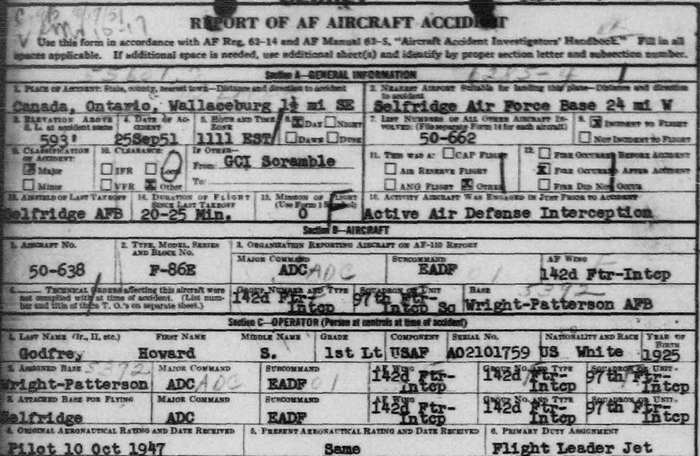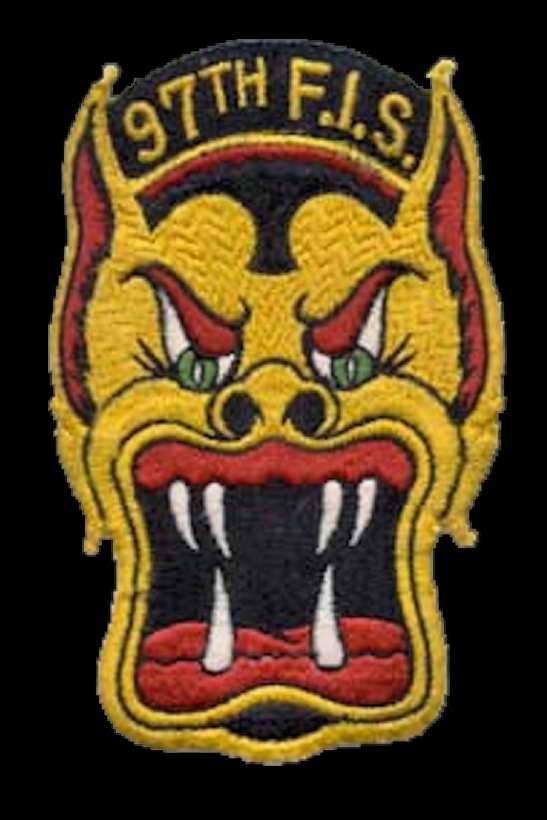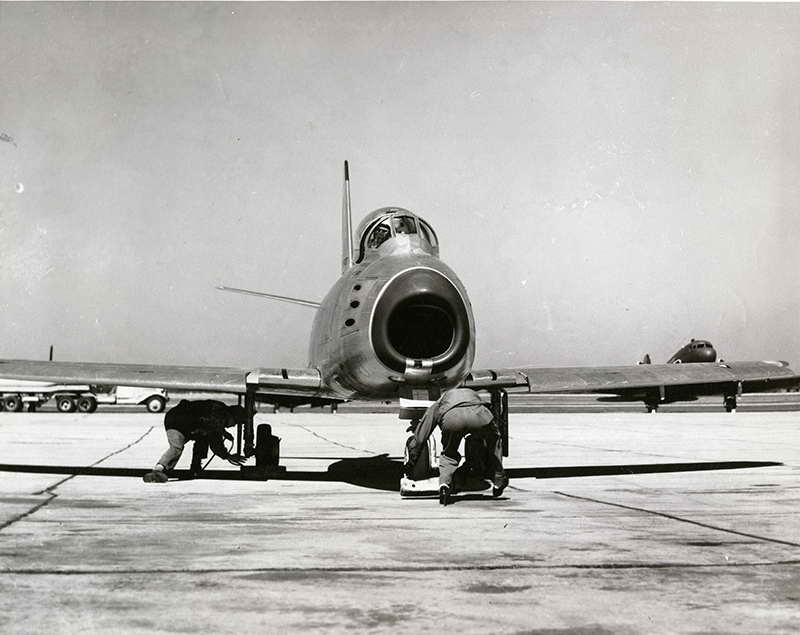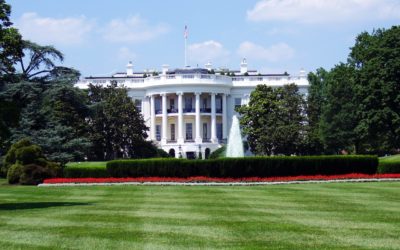An Airplane Crash Brings the Cold War to Wallaceburg, Ontario.
As a new decade dawned in the 1950s, the immediate aftermath of World War II had led to new conflicts between recent allies. The United States and the Soviet Union, the world’s two remaining superpowers, had turned their ire towards each other after the defeat of the Axis powers which brought the end to the war. Determined to spread their political ideologies and safeguard themselves from each other, a new conflict arose. Called the Cold War, this was a conflict mostly of politics and posturing, with the occasional regional shooting war fought by proxies for the opposing sides.
Part of the real danger was from a major change in tactics that came about once the Soviet Union was able to develop its own nuclear bomb. By 1950 all a military had to do was get one bomb over its target, and that bomb could then lay waste to an entire city. The most likely threat to either side came from airplanes. The United States responded by developing new aircraft to counter any threat from Russia. The most experienced pilots in the United States Air Force (USAF) had most of their flying time in piston-powered aircraft from World War II but were now transitioning to new, jet-powered fighters. These planes were better in nearly every way, but the rapid advancement of technology outpaced the development of tactics, procedures, and safety.
This, it seemed, was only relevant to those in the military. The residents of Wallaceburg, Ontario, like the vast majority of people in small cities all around the world, we’re focused on local, everyday issues. World-wide political struggles and events were more background noise than everyday reality. It was true that even in this small southwestern Ontario city, residents had felt the deprivation of rationing and the fears of losing loved ones during World War II. People were aware that a conflict in Korea had developed, and threatened to grow into a direct confrontation between the United States, her allies, and the Soviet Union, but that threat and any impact it may have seemed distant.
Occasionally the growl of USAF jets flying over the area reminded the people in and around Wallaceburg of a military presence. However, the thought of being the setting for any cold war event, no matter how small, was pretty far-fetched. As the sun rose over the city on September 21, 1951, filling the air with warm sunshine and puffy, white clouds, farmers headed to their fields to tend to their crops of wheat and corn while others had their breakfast and drove off to work. It seemed destined to be a normal autumn day in southwestern Ontario.
Far away in the planning rooms that held strategy sessions for the US Military, decisions had been made that would shatter the tranquility of that autumn day. Before lunchtime, two planes would fall from the sky, trailing smoke, fire, and blood. The jarring crash of two U.S. F-86 Sabres would bring the reality of the Cold War to the doorsteps of Wallaceburg. The town would bear witness, this day, to the constant danger that surrounded USAF pilots and the sacrifice those pilots would be forced to make at any moment.
Military planners recognized that places like Wallaceburg, which were close to the border of the U.S., could potentially become the front lines of a major conflict between the Soviet Union and the United States. Daily, all across the world, the Soviet Union and the United States were constantly playing a cat and mouse game that tested each other’s air defenses. These probes happened randomly, and each potential incursion had to be treated as the opening shot of a surprise nuclear strike. Much of Canada, the USAF believed, was airspace that needed to be defended from Soviet encroachment at all times.
In order to do that, the airspace around the borders of the United States was divided up into various zones of defense, and groups of fighter aircraft were tasked with training, patrol, and interception missions in order to defend that airspace. Where it extended over Canadian soil, Canada was happy to allow the USAF access and freedom to patrol the skies above the country. Most of Ontario fell under the protection of the Eastern Air Defence Force (EADF) which included the 142nd Fighter Wing based out of Wright-Patterson Air Force Base in Dayton, Ohio.
“Wings” are made up of “Squadrons” and by September 1951, the 97th Fighter-Interceptor Squadron known as the “Devil Cats” had been sent by the 142nd up to Selfridge Air Force Base. This base lies about 15 miles north of Detroit and 10 miles west of the Canadian border. The Devil cats were to patrol the section of the EADF which extended over southwest Ontario and included Wallaceburg. Because the facility was so close to the border between Ontario and Michigan, the sight and sound of USAF jets in the sky was common.
The USAF pilots who flew those planes were having to cope with rapidly changing technology and flight characteristics of their aircraft while also performing their duties. This often led to oversights in training and operating procedures. Some squadrons were able to keep up with the required changes, while others got along with a mix of new and old procedures; amalgams of unevolved ideas and concepts from World War II, new concepts, and the experience of their current pilots. This made a dangerous occupation even more so, and some squadrons, like the Devil Cats, were experiencing a higher than normal rate of accidents and incidents.
The Devil Cats had also recently taken delivery of a new airplane. In the early 1950s, the F-86 was the USAF’s newest and most capable jet fighter. From wingtip to wingtip, the plane was 37 feet across, 37 feet long, and 14 feet high from the ground to the top of the tail. It was not a large airplane. Most variants had a gaping air inlet instead of a nose at the front to feed the jet engine and a set of wings swept back to the tail at a daring angle. In April 1951, the 97th had received the F-86E, the latest variant of the Sabre jet which brought with it an increase in power and maneuverability.
The pilot sat under a bubble canopy that allowed him to see all around his airplane. At his fingertips sat the trigger that would fire the six machine guns mounted in the nose, three to each side. The design allowed the Sabre Jet to fly just under the speed of sound in level flight, and go supersonic in a dive. These were jets that the pilots liked to fly. They were fast, maneuverable, and a match for the MiG-15 currently used in the Soviet arsenal.
Selfridge Air Force Base received an alert shortly before 11 AM. Radar had picked up an unknown plane flying inbound towards the United States and in particular towards the major manufacturing city of Detroit, MI. The base normally kept planes fueled and ready along with their pilots on what was called Alert Missions.
Alert missions were designed to provide a deterrent to any attempted incursion by Soviet Airplanes, which would have most likely been nuclear bomb equipped bombers. Pilots were kept at the ready, near their planes. If a hostile or unknown aircraft was detected, the flight could scramble and be airborne in minutes, and then guided to intercept their target by ground radar. Once located the target could be identified and then shot down if needed. These types of missions were common and a critical strategy that gave the United States the ability to defend its borders and prevent the incursion of Soviet bombers into U.S. airspace.
On alert that day was 1st Lt Howard Godfrey, from Unionville, MO., who had become a pilot in the USAF in 1948. He had accumulated a large number of flight hours in a variety of airplanes and had combat experience in Korea. With him in the ready room was his wingman, 2nd Lt. Daniel Means, from St. Albans, West Virginia, a newer pilot with significantly less experience.
Within 3 minutes of getting their orders, the pilots were taxiing out to the runway. This mission would be flown as a ground control intercept, which meant that the flight would be guided to the target by a controller, call sign “Avenger”, who was looking at radar from the ground.
Avenger instructed the flight to take off and climb to 10,000 feet heading East. As the pair of jets departed, the loud roar of their engines filled the cockpits and shook the ground. As they climbed and turned in the direction of their target, the planes flew in formation as Lt. Means tucked his jet in close behind his flight leader’s right wing. He was known to like to fly a tight formation in relation to the flight lead, a practice that was often celebrated when flying the piston-powered planes and early jets in the Air Force inventory at the time. And so it was this day as they headed off to search for the inbound bogey.
As Catbird Red crossed from Michigan to Ontario, the planes passed over a checkerboard of farm fields and small towns. Broken clouds floated lazily below them at 6000 feet, casting shadows across the corn and wheat fields that lay below. Flying nearly two miles up, the agricultural landscape below looked peaceful and visibility extended for over 15 miles around them.
After a few minutes of flying and not being able to locate the target, Avenger instructed them to begin a right turn and descend to 6000 ft while looking both high and low for the target. At this altitude, there were a few broken clouds. Catbird Red had orders to fly only Visual Flight Rules. Which meant they were not to fly through the clouds. Avenger continued to issue instructions, directing them to fly an oval around the target location, performing a turn that should put the bogey on Catbird Red’s nose, just off to the right.
At first Lt. Godfrey couldn’t see the target as he looked through the broken, puffy clouds. As he flew on, he eventually acquired the incoming plane. At 11:11 in the morning, he called out “Tally Ho!” meaning he had found his quarry. Avenger replied, “Is it a civilian aircraft?”
At this moment, Frank Stevens, who was working on a farm on the outskirts of Wallaceburg, Ontario, happened to be outside working in the silo. The growl of the Sabre jets caught his attention and from the ground, he watched as the pair of jets comprising Catbird Red intercepted another plane. He stated, “The two planes in formation appeared to come close to the other plane. One plane of the two appeared to turn right and into the other plane and they hit.” A mile above the peaceful countryside, Catbird Red fell from the sky.
Officially, no one will ever know exactly what happened, but the evidence allowed for the investigators to reconstruct a likely sequence of events. The flight lead, Lt. Godfrey, likely made a sudden turn to the right. He may have been avoiding a cloud or just looking to get a better view of the target airplane. Lt. Means, flying off Lt. Godfrey’s right wing did not react in time. It is possible he was blinded by the sun, but it was just as likely that he was in too tight on his flight leader. As they performed their turn as ordered by Avenger, the two Sabre Jets collided; Lt Mean’s aircraft making contact with his flight leader’s right side, in front of the tail section. As the collision happened, Lt. Godfrey’s jet split in half, with the tail section, still under the power of the engine, ripping through the cockpit area of his jet. He was killed instantly.
Lt. Mean’s F-86 began to fall from the sky in a smoking spiral. From 6000 feet there was not much time to react. He fought the dying plane and managed to level out, almost back in control. But the jet then began to disintegrate and went back into a dive. With no other options, the pilot ejected from the plane, but these early ejection seats required the pilot to eject and once in the air, manually get away from the seat and pull the parachute open. This requires a certain amount of altitude, altitude which had already been lost. Lt. Means was able to leave the crippled aircraft, but not his seat, and perished upon impact with the ground.
Both aircraft came down just south of Wallaceburg. Lt. Mean’s plane landed on a farm between two barns, both of which caught fire. The farmer’s wife, Helen Demeester, escaped death by just a few feet as she was outside yards away from the impact site. She did suffer a small wound as she was hit by pieces of the crashing plane. The pilot’s body was discovered in the farm’s tomato patch, still strapped into his seat. Lt. Godfrey’s plane, having broken up in the air, was scattered over a quarter-mile with the main crash site on a different farm nearly a mile away. The police and fire department was called, and news of the loss of Catbird Red made its way around the small city and finally to Selfridge Airforce base.
As base personnel scrambled to attend to the crash site, they were required to take a boat across the St. Clair River and into Canada and then travel to the scene by car. This took about two hours, in which time people from around Wallaceburg had come to the crash site and started collecting souvenirs. The ground was littered with live ammunition which was easy to collect, along with other bits of metal from the crash. The helmets and breathing gear of both pilots disappeared as well. The local coroner had been brought out and they had already collected the bodies of both pilots. The investigators found a crash scene that was severely compromised.
As clean up began, a call was put out in the local newspaper asking for people to return what they had taken. Ammunition and other bits were brought back, along with the helmets that had been taken. The return of Lt. Godfrey’s helmet was critical in helping the investigation team understand what had happened in the sky by the damage it had sustained.
Over the course of months, interviews were conducted and policies were reviewed. The Air Force determined that, for a variety of reasons, the 97th Squadron had not formally adopted a standard operating procedure for intercept flights. One that would have stated a minimum distance between lead and wingman and would have prevented flying a tight formation on intercept missions would have prevented this accident. It also found that training on ejection procedures was lacking in the squadron. Investigators recommended that rapid approval be given for a mechanism already being demonstrated that would automatically separate a pilot from his seat and deploy the chute. Exiting seats, the Air Force determined, could be easily upgraded at minimal time and cost. This technology could have saved Lt. Mean’s life and certainly would save others in the future.
Within an hour of Cat Bird Red’s impact with the ground, the crew of Trans-Canada Flight 31 out of Toronto landed in Windsor, Ontario, and delivered the mail. They were completely oblivious to what had happened. They never even saw the planes of Catbird Red and had no idea that they had been the target of an intercept mission. Ultimately the Sabre Jet pilots had been tasked to intercept a Trans-Canada DC-3, the civilian version of the C-47 made famous in the paratrooper drops over Normandy on D-Day. This incident underscored the need for the United States and Canada to develop a way for their air traffic control systems to share information with the USAF. Interception of civilian flights over Canada was not a rare occurrence, a fact borne out by Avenger’s unanswered question: “Is it a civilian aircraft?”
Lt Means and Lt. Howard both left behind parents, friends, and comrades. They died in defense of North America, far from any war, near a city far removed from the front lines of conflict. Today, their non-descript cemetery stones mark their burial plots in their hometowns, their story largely forgotten, the only reminder of lives lost.
Quotes, facts, and feature image from the official USAF crash report
97th Fighter-Interceptor Squadron Emblem from the United States Air Force, Public domain, via Wikimedia Commons
F-86 Photo from the Wright State Universities Special Collections and Archives Out of the Box Blog.
Crash photos courtesy of the Chatham Daily News archives from the Chatham-Kent Museum










I remember that day very well. I was walking down Wallace St. when I saw the two planes crash. After work my friend and I walked out to Baseline where the planes where but could not get close. By 5 p.m. Wallaceburg looked like the U.S. the streets were closed except for the U.S. airforce from Selfridge Airforce
I was fascinated when I heard this story and it seemed like there wasn’t any consistent information. It was a good research project and one of these days I want to go over to the site. I know there isn’t anything there, but these guys died defending N. America and something about that draws me there.